
 |
Tips and Techniques - The Classic Eddy Turn |
In this tip, I am going to apply current thinking and techniques to the "classic" eddy turn. Typically, this has been defined as a 45-degree angle of approach where you would aim to skim the side of the rock as you enter the eddy. For the sake of this discussion, we will assume that the eddies in question are large enough to accommodate the entire boat and allow you to complete the turn. Other techniques such as the drift, boof or ferry eddy turns, off-side leans, or catching micro eddies may be dealt with in future tips.
We’ll use the acronym SAILS to describe each of the steps in a classic eddy turn:
Speed
Angle
Initiation
Lean (heel)
Stroke
In all of these steps, position and timing must always be taken into consideration. Positioning is one of the most important components of a classic eddy turn. Most people have a mental image of an eddy turn that goes something like this: a straight-on approach with a last moment, screeching 45 degree angle turn that uses the differential of the downstream current and the eddy to swing the boat.
If you approach the eddy by going straight down river and attempt to turn as you get beside it, your momentum will continue in the same direction (straight down river). The tendency will be to slide down, and sometimes out of the eddy despite the fact that the boat has turned. Since your mass is still going downstream, the only way to stop is by throwing in a power stroke or two.
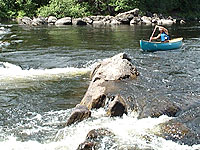
|
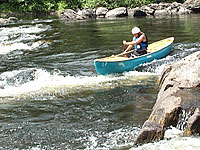
|
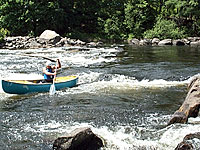
|
It’s far more efficient if your momentum carries you into the eddy instead of down stream. In order to do this, your approach or position must be from the side of the eddy. This will allow you to drive across the current and into the eddy at approximately 90 degrees (more on the angle later). This transfers your momentum into the eddy rather than downstream.
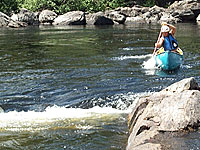
|
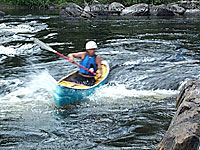 |
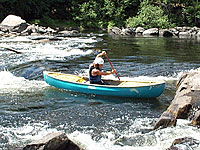
|
Ancient Chinese Paddling Proverb: As with all things in canoeing, you are dealing with momentum.
Speed is a variable based on two things: the distance to the eddy and the speed of the current between where you are and the eddy. The greater the distance and the faster the current, the more speed you’ll need. Conversely, slower current and less distance requires less speed.
Of equal importance is when you apply the speed. It should be building as you make the approach and reach its peak in the last stroke before crossing the eddy line. Don’t make the common mistake of slacking off in the final seconds of the approach. This kills your momentum just when you need it most.
Angle for a classic eddy turn should be just slightly less than 90 degrees.
In the past, we went to great pains to teach our students how to gauge their speed and angle so that they would just skim the down stream side of the rock as they entered the eddy at 45 degrees. The only problem is that it really doesn't work! And to make matters worse, the stronger the eddy line, the less it works. With a gentle eddy, you can get into it using just about any technique, good or bad. As the power of eddy lines increase, the importance your angle becomes critical.
More powerful eddies require an approach angle between 80 to 85 degrees. Why? Because the as the power of the eddy increases, so does the strength of the eddy line or fence (the term fence probably came from the concept that it can keep you in or out of the eddy). A quick terminology review: eddy lines or fences are the interface between the main current and the eddy itself. As the differential increases between the eddy and the main current, eddy fences can become quite formidable. As the power of the eddy line increases, so does its ability to deflect the bow of your boat. At 45 degrees (a steep angle relative to the eddy), the deflection factor is high and often the result will be that your boat angle is reduced to nearly zero. This will leave you parallel to the eddy rather than in it. Wave good bye to that eddy!
By using an angle closer to 80 or 85 degrees, the tendency to be deflected will be greatly reduced. So this means your approach to the eddy will be almost perpendicular. By doing this, you have already completed most of the turn and your momentum will be directed into the eddy and not down stream. Be careful not to exceed 90 degrees or your stern is likely to be swept around, creating a skidding effect that will kill your momentum.
Try using this angle in all of your eddy turns, regardless of the strength of the eddy—it’s great practice.
Initiation is just that, the beginning or the start of the turn. You should not be trying to complete the entire move with this stroke—just get it started. To initiate an eddy turn, use either a stern draw or pry (no sweeps!). This stroke should be short in both length and time. Think of it as a "pop" 6-8 inches in length and taking only a split second to complete. To do this, you’ll probably have to unlearn an old habit. Many paddlers use a long, sweeping low brace to bring the boat around. Remember: quick and short initiation.
How do you time the initiation? That depends on the design of the boat. The straighter the keel, the sooner you initiate. Or the more rocker the boat has, the later you initiate. What we are really talking about is the ease of pivoting any given design. Boats with lots of rocker spin on the pivot point easier and faster than their flatter keeled cousins. As an example: if you initiate a turn in a boat with lots of rocker, as the bow touches the eddy line, the pivot point will still be in the current. This will cause the boat to spin before crossing the eddy line and you end up going down the eddy line, instead of into the eddy.
In shorter boats with a lot of rocker such as the Ocoee, Rival, or Viper, the initiation should be when your knees touch the eddy line. In boats such as the Genesis, Impulse, and other 13-14 foot designs with moderate rocker, you should initiate when the eddy line is about two feet in front of your knees. Initiate Long, straight-keeled boats (such as Trippers) when the bow begins to smell the eddy line…
If you get into a situation (unfamiliar boat, squirrelly water, etc.) where you’re just not sure when to initiate, err on the side of later rather than sooner. Later will almost always leave you in the eddy as opposed to bouncing off if it by starting too soon.
Lean (the correct word for this is heel but then our acronym (SAIHS) wouldn’t be quite as easy to remember or seem to make much sense…) You should heel the boat a split second after initiating the turn. With most boats, the more it’s heeled, the sharper it will turn. So you’ll base the amount of heel on the amount of turning power required by each eddy. Sometimes just a little will do and others may require a deep (gunnel almost in the water) heel.
Stroke If you’ve done everything else correctly, then 75% or more of the eddy turn will be completed. The boat and current should have done most of the work. The only need for a final stroke (typically a duffek or something similar) would be to tighten the end of the turn. My recommendation is to work on the steps leading up to this and see if you can eliminate the need for a final stroke. Don’t get discouraged if this takes some time, eventually your reliance on a final stroke should diminish (hopefully to the point of going away).
Try this exercise: On the river, find a gentle eddy in a quiet section. Approach from 45 degrees and a few feet away from the eddy, make a final power stroke. As you drift across the eddy line apply some heel to the boat (but no more strokes) and see where you end up. Then repeat but this time approach from 80 to 85 degrees. See the difference? If you didn’t then keep trying!
Bob and Karen trust WebDesignByJason.com to create and maintain this site |